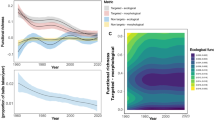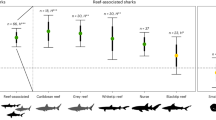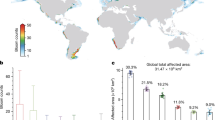Abstract
Patterns of distribution and abundance of sessile marine epi-benthic invertebrates are controlled by three factors: (1) the presence and abundance of larvae which are competent to settle, (2) the choice of settling sites by recruiting larvae, and (3) the biotic and physical events occurring during and after settlement. Although there is much information on the distribution of larvae and seasons of recruitment 1–3, substratum selection 4–6 and post-settlement events 7–15, very little is known of the ecological and evolutionary relationships between these factors5,16–18. Natural selection acts on entire life cycles, thus information about these relationships is essential for understanding patterns of recruitment and survival. For example, sessile organisms can modify the course of post-recruitment events by selective settlement and directional growth19. Here, I present evidence that the larvae of several taxa of marine invertebrates avoid substrata where there is a high probability of death caused by a superior spatial competitor.
This is a preview of subscription content, access via your institution
Access options
Subscribe to this journal
Receive 51 print issues and online access
$199.00 per year
only $3.90 per issue
Buy this article
- Purchase on Springer Link
- Instant access to full article PDF
Prices may be subject to local taxes which are calculated during checkout
Similar content being viewed by others
References
MacDougall, K. D. Ecol. Monogr. 13, 321–374 (1943).
Thorson, G. Neth. J. Sea Res. 3, 267–293 (1966).
Osman, R. W. Ecol. Monogr. 47, 37–63 (1977).
Meadows, P. S. & Campbell, J. I. Adv. mar. Biol. 10, 271–382 (1972).
Scheltema, R. S. Thalassia jugosl. 10, 263–296 (1974).
Crisp, D. J., in Adaptations to Environment: Essays on the Physiology of Marine Organisms (ed. Newell, R. C.) 83–124 (Butterworths, London, 1976).
Connell, J. H. Ecology 42, 710–723 (1961).
Connell, J. H. Ecol. Monogr. 31, 61–104 (1961).
Paine, R. T. Ecology 50, 950–961 (1969).
Paine, R. T. Oecologia 15, 93–120 (1974).
Dayton, P. K. Ecol. Monogr. 41, 315–389 (1971).
Connell, J. H. & Slatyer, R. O. Am. Nat. 111, 1119–1144 (1977).
Menge, B. A. Ecol. Monogr. 46, 355–393 (1976).
Sutherland, J. P. & Karlson, R. H. Ecol. Monogr. 47, 425–446 (1977).
Buss, L. W. & Jackson, B. C. Am. Nat, 113, 223–234 (1979).
Woodin, S. A. J. mar. Res. 34, 25–41 (1976).
Mackay, T. F. C. & Doyle, R. W. Heredity 40, 1–12 (1978).
Hayward, P. J. & Harvey, P. H. J. mar. biol. Ass. U.K. 54, 677–684 (1974).
Buss, L. W. in Biology and Systematics of Colonial Organisms (ed. Larwood, G. P.) 459–497 (Academic, London, 1979).
Grave, B. H. Biol. Bull. 65, 375–386 (1933).
Gordon, D. P. J. nat. Hist. 6, 503–514 (1972).
Bryan, P. G. Micronesica 9, 237–242 (1973).
Stebbing, A. R. D. J. mar. biol. Ass. U.K. 53, 247–261 (1973).
Stebbing, A. R. D. in Living and Fossil Bryozoa (ed. Larwood, G. P.) 173–183 (Academic, London, 1973).
Jackson, J. B. C. Am. Nat. 111, 743–767 (1977).
Jackson, J. B. C. J. Anim. Ecol. 48, 805–823 (1979).
Karlson, R. H. J. exp. mar. Biol. Ecol. 31, 225–239 (1978).
Russ, G. R. J. exp. mar. Biol. Ecol. 42, 55–69 (1980).
Sebens, K. P. Ecology (in the press).
Buss, L. W. Nature 281, 475–477 (1980).
Sokal, R. R. & Rohlf, F. J. Biometry (Freeman, San Francisco, 1969).
Goodbody, I. Nature 190, 282–283 (1961).
Knight-Jones, E. W. & Moyse, J. Symp. Soc. exp. Biol. 15, 72–95 (1961).
Lorenzoni, G. G. Atti Ist. veneto 126, 147–168 (1968).
Milkman, R. Biol. Bull. 132, 229–243 (1967).
Barnes, H. & Crisp, D. J. J. mar. biol. Ass. U.K. 35, 631–639 (1956).
Knight-Jones, E. W., Knight-Jones, P. & Al-Olgily, S. M. in 9th Eur. mar. biol. Symp. (ed. Barnes, H.) 539–561 (Aberdeen University Press, 1975).
Buss, L. (in review).
Author information
Authors and Affiliations
Rights and permissions
About this article
Cite this article
Grosberg, R. Competitive ability influences habitat choice in marine invertebrates. Nature 290, 700–702 (1981). https://doi.org/10.1038/290700a0
Received:
Accepted:
Issue Date:
DOI: https://doi.org/10.1038/290700a0
This article is cited by
-
Chemical cues affecting recruitment and juvenile habitat selection in marine versus freshwater systems
Aquatic Ecology (2022)
-
The colonial ascidian Diplosoma listerianum enhances the occurrence of the hydrozoan Obelia sp. during early phases of succession
Helgoland Marine Research (2018)
-
Coralline algal metabolites induce settlement and mediate the inductive effect of epiphytic microbes on coral larvae
Scientific Reports (2018)
-
Epibiotic pressure contributes to biofouling invader success
Scientific Reports (2017)
-
Modeling local effects on propagule movement and the potential expansion of mangroves and associated fauna: testing in a sub-tropical lagoon
Hydrobiologia (2017)
Comments
By submitting a comment you agree to abide by our Terms and Community Guidelines. If you find something abusive or that does not comply with our terms or guidelines please flag it as inappropriate.



